“If AI code generators were apprentices, Agentic App Builders are engineers who can think.”
They don’t just output lines of code – they understand your intent, structure it, generate production-ready apps, test, deploy, and learn from their results. In this article, we unpack how this next generation of tools quietly redefines how software gets built – and why it matters more than ever.
When people search for Agentic App Builders, they usually ask:
- Can these systems really build entire apps, not just snippets of code?
- How are Agentic App Builders different from AI code assistants or low-code platforms?
- Are they reliable enough for production-grade systems?
- What tools, stacks, or frameworks power them today?
Over the past year, we’ve seen growing confusion – and excitement – around the limits of AI in software development. Our own Flatlogic Research on Starting Web Apps in 2025 confirmed the trend: developers love the speed of AI-driven tools, but 67% said they still struggle with code stability, context loss, and maintainability. The promise of faster development remains locked behind unreliable generation. Agentic App Builders emerged as the practical answer to this gap – combining AI planning with deterministic, testable code generation.
You can trust our perspective because we’ve lived this transformation firsthand. Flatlogic has spent more than a decade building and refining code generation systems – from early admin templates to the Flatlogic Generator and now AppWizzy, our professional vibe-coding platform. We’ve helped startups and enterprises worldwide create real SaaS, CRM, and ERP systems that scale. Our experience spans the full journey: manual coding, automation, and now the agentic paradigm.
By the end of this article, you’ll understand what Agentic App Builders are, how they actually work, what makes them reliable, and how they differ from everything that came before – plus, you’ll see concrete examples of how teams use them today to cut development time from months to weeks without losing code ownership or quality. 
What Is an Agentic App Builder?
Agentic App Builders are a new generation of AI-powered systems designed to plan, generate, test, and deploy complete applications autonomously – not just suggest snippets of code.
They bridge the gap between AI assistants that can write code and software engineers who build systems.
An Agentic App Builder is an AI developer with structure: it understands your goal, translates it into a formal schema, generates production-ready code using deterministic templates, validates the output through testing, and continues iterating until the result meets your defined criteria.
Unlike most “AI coders” that rely on single-shot prompts, Agentic App Builders work in loops – they reason, act, verify, and refine.
They maintain context over multiple steps, treating development as a continuous process rather than an isolated completion.
How Agentic App Builders Work
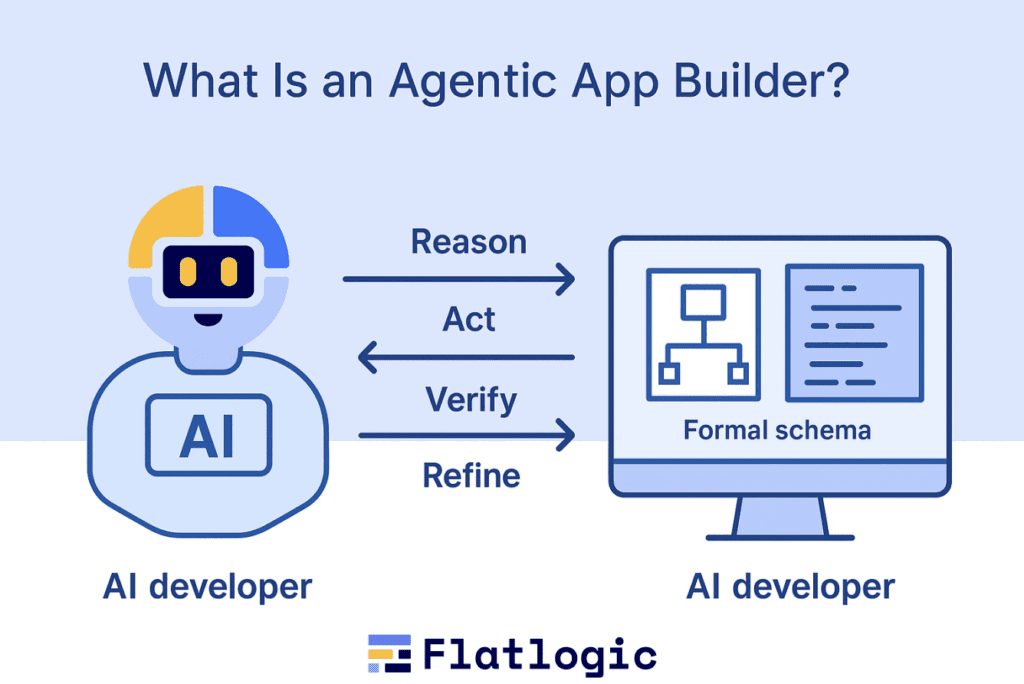
Let’s break the process down step-by-step:
| Stage | Description | Example |
| 1. Intent Understanding | The system interprets your goal (“Build a CRM for 3 user roles with analytics”). | AI converts plain English to structured objectives. |
| 2. Schema Generation | It creates a JSON/ER diagram that defines entities, relations, and roles. | users, deals, reports, roles |
| 3. Code Generation | A deterministic template engine (like Flatlogic Generator) turns that schema into working code. | Node.js + Next.js + PostgreSQL app |
| 4. Testing & Validation | Automated checks (unit tests, migrations, lint) run automatically. | The AI agent fixes failed tests and regenerates. |
| 5. Deployment & Feedback | Code is deployed (e.g., to Google Cloud Run), monitored, and iterated. | The system analyzes logs, performance, and user metrics. |
This closed-loop behavior is what makes the system agentic – it acts with purpose, evaluates outcomes, and learns from them.
Top 10+ Agentic App Builders in 2025
In 2025, we can already see a clear divide between tools that generate code and those that actually manage the development process end-to-end. Below are some of the most promising Agentic App Builders that combine structured AI reasoning, deterministic generation, and workflow automation. Each has a different philosophy – from fully open-source frameworks to commercial “AI engineers.”
AppWizzy
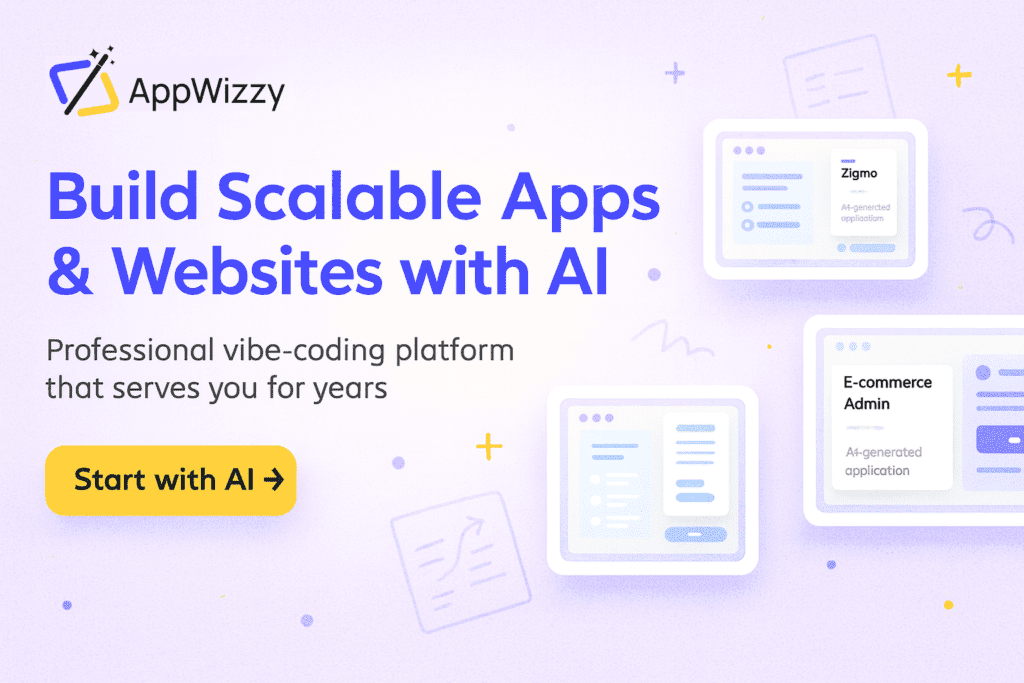
AppWizzy Professional Vibe-Coding Platform – represents one of the most advanced implementations of Agentic App Builders today. It uses a hybrid AI + deterministic model: the LLM extracts structured specifications from natural language, and a rule-based generator turns them into complete, production-ready web applications. Every project includes authentication, roles, CRUD, dashboards, and deployment pipelines.
Key features:
- Deterministic, schema-driven code generation (Next.js, Node.js, or LAMP).
- AI-assisted schema editing and conversational app building.
- GitHub integration, rollback, and version control are built in.
- Automated deployment to Google Cloud Run.
- Full code ownership and export.
Target audience:
Startups, software development companies, and founders who want to move from concept to deployable MVP within days while maintaining complete control of their codebase.
Pitfalls:
Requires basic technical understanding – not a pure no-code experience. Some advanced AI features (like incremental self-fixing) are still being rolled out.
Pricing:
Free tier for small apps; paid tiers from $29/month (hosted) to enterprise custom plans.
Lovable.ai
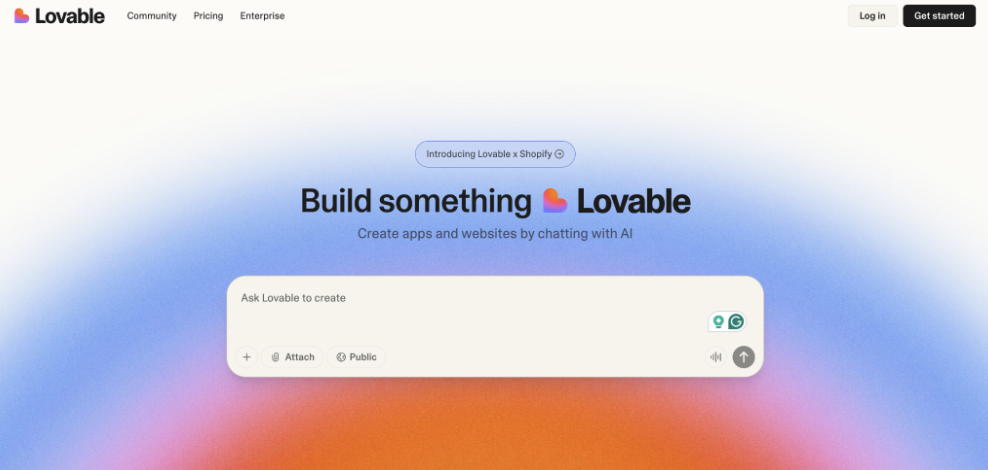
Lovable positions itself as an “AI engineer that ships web apps for you.” It’s one of the earliest commercial platforms to adopt an agentic model, focusing on rapid MVP generation with minimal human input. The system converts descriptions into working Next.js + Supabase projects in minutes.
Key features:
- Conversational app creation with natural language.
- Auto-deployment and live editing.
- Version control and hosting built in.
Target audience:
Solo founders and small teams validating SaaS or internal tool ideas.
Pitfalls:
Limited customization and closed architecture. Generated code can be difficult to extend beyond the initial scope.
Pricing:
Freemium model; paid plans start at $39/month.
Bolt.new
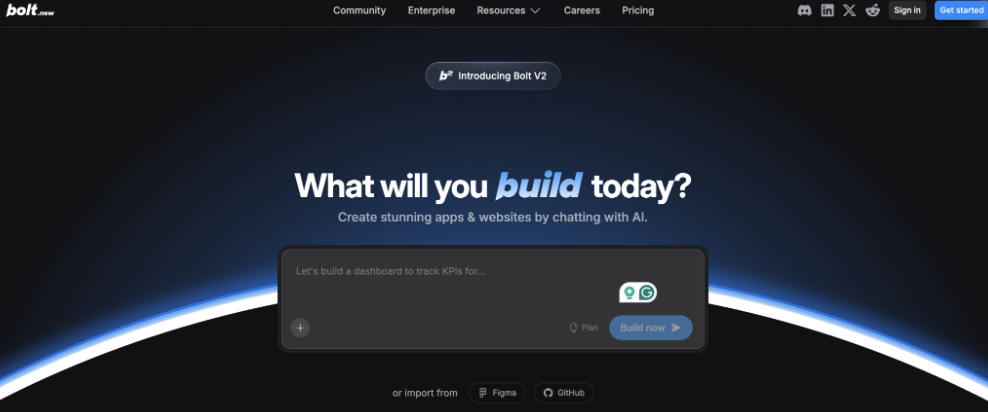
Bolt takes a collaborative approach to AI development – users can chat with multiple “agents” specialized in design, logic, and deployment. The tool focuses on creating modern web apps using React, Tailwind, and Firebase.
Key features:
- Multi-agent collaboration for faster feedback loops.
- Real-time code editing in the browser.
- Integration with major design-to-code tools.
Target audience:
Frontend developers and product designers who want to skip scaffolding and focus on UI logic.
Pitfalls:
Limited backend capabilities; projects often need manual wiring for complex data models.
Pricing:
Free trial; Pro tier at $29/month per user.
Replit Agent (Replit AI)
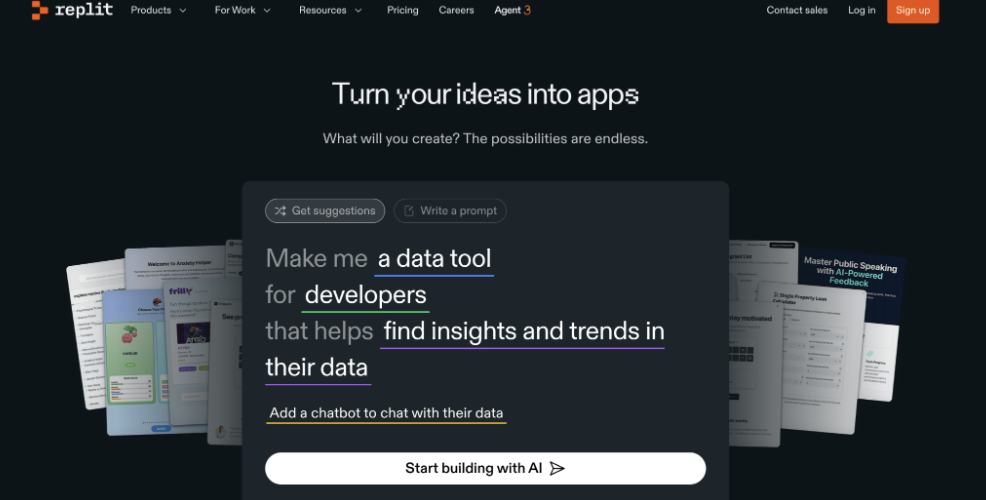
Replit expanded its Ghostwriter tool into a full Replit Agent capable of autonomous project creation and refactoring. It integrates tightly with the Replit IDE, making it one of the most accessible Agentic Builders for individual developers.
Key features:
- Context-aware coding and debugging.
- Environment provisioning and live preview.
- Works across 50+ languages.
Target audience:
Developers who already use Replit and want an AI assistant that can build, test, and refactor small to medium projects autonomously.
Pitfalls:
Less suitable for enterprise-grade systems; lacks deterministic code reproducibility.
Pricing:
Included in Replit Core ($20/month).
Cognition Labs “Devin”

Often called “the world’s first AI software engineer,” Devin focuses on autonomous project execution. It can read tickets, plan tasks, write code, and run tests – simulating a full engineer’s workflow.
Key features:
- Multi-step task planning and execution.
- Built-in terminal and browser environment.
- Can integrate with GitHub Issues and Jira.
Target audience:
Engineering teams exploring agentic collaboration – “pair programming” between AI and humans.
Pitfalls:
Currently in closed beta; high compute cost and limited reproducibility for enterprise use.
Pricing:
Enterprise pricing (invite-only).
v0.dev (by Vercel)
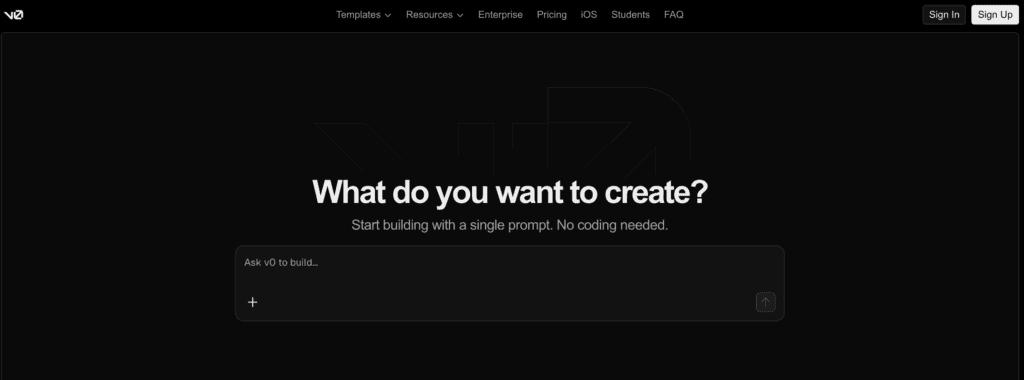
v0 is Vercel’s AI-powered builder designed for frontend development with a focus on UI and design components. While not fully agentic yet, its upcoming workflow engine brings elements of planning and self-improvement into code generation.
Key features:
- Generates React components with Tailwind CSS.
- Integrates seamlessly with Vercel deployment.
- Iterative editing via natural language.
Target audience:
Frontend engineers and designers creating UI-heavy SaaS dashboards or marketing tools.
Pitfalls:
Still limited to the presentation layer; no business logic or backend generation.
Pricing:
Free during beta; paid tiers expected with Vercel Pro plans.
GitHub Copilot Workspace
GitHub Copilot Workspace extends Copilot’s capabilities into full repository management – agents that can plan, edit, and refactor entire projects. It represents GitHub’s first move toward true Agentic App Building.
Key features:
- Task planning and multi-file context awareness.
- Code suggestions, testing, and pull-request automation.
- Deep integration with VS Code and GitHub Actions.
Target audience:
Developers already embedded in the GitHub ecosystem who want contextual automation within their repos.
Pitfalls:
Still early-stage and tightly coupled with GitHub infrastructure; limited flexibility for external deployment.
Pricing:
Included in Copilot Pro ($19/month).
SuperAGI
SuperAGI is an open-source agentic framework that allows developers to build, host, and customize AI agents for software development tasks. It’s aimed at technical users who want full control over the agentic pipeline.
Key features:
- Agent orchestration and tool integration.
- Extensible via plugins and APIs.
- Visual dashboards for tracking actions.
Target audience:
Technical founders, AI researchers, and devops engineers experimenting with custom agent workflows.
Pitfalls:
Requires setup and infrastructure knowledge; not turnkey for non-technical users.
Pricing:
Free and open-source (self-hosted).
Autonolas
Autonolas focuses on decentralized multi-agent systems, bringing blockchain-grade governance into the world of AI software agents. It’s more experimental but conceptually aligned with the Agentic Builder trend.
Key features:
- Multi-agent coordination across distributed environments.
- Autonomous decision-making with transparency and logs.
- Supports integration with smart contracts.
Target audience:
Researchers and advanced teams exploring AI-governed infrastructure and on-chain automation.
Pitfalls:
Complex architecture; not designed for everyday web app building.
Pricing:
Open-source, free to use.
Cognosys
Cognosys aims to make autonomous development accessible to non-developers through a web interface where AI builds, tests, and deploys apps in real time. It’s part of the “visual agentic” generation of tools.
Key features:
- Visual goal definition and progress tracking.
- Multi-agent execution with self-correction.
- Cloud deployment and collaborative editing.
Target audience:
Product managers and entrepreneurs who want to prototype complex workflows without coding.
Pitfalls:
Limited transparency into code structure and dependencies; best suited for prototypes.
Pricing:
Free trial; Pro plan around $49/month.
Dust.tt
Dust lets teams orchestrate LLM-based agents that can read docs, connect to APIs, and perform software tasks collaboratively. It’s not a builder in the traditional sense but a strong foundation for agentic workflows.
Key features:
- Multi-agent orchestration and memory management.
- Integrates with GitHub, Notion, and databases.
- Strong developer API.
Target audience:
Companies are building internal AI tools or custom pipelines rather than full apps.
Pitfalls:
Requires programming skills to design and connect workflows.
Pricing:
Free tier; paid plans start at $30/month.
How to Choose the Best Agentic AI Builder
Choosing the right Agentic App Builder in 2025 isn’t about picking the most hyped name – it’s about finding the system that fits your stack, workflow, and long-term control needs. These tools differ dramatically in architecture, transparency, and maturity. Some emphasize quick prototyping, others enterprise-grade reliability and code ownership. Below are the five core criteria we recommend evaluating before committing to any Agentic AI Builder.
1. Code Ownership and Exportability
Ask first: “Do I fully own the code this AI creates?”
Many “AI builders” host your project in closed systems, making it difficult to export or maintain outside their platform.
A true Agentic App Builder should produce code you can host, audit, and extend – just like software written by your team.
| Factor | Why It Matters | Flatlogic Example |
| Full Export | Let’s you move between providers or self-host. | All apps generated in Flatlogic Generator and AppWizzy can be downloaded and deployed anywhere. |
| Readable Structure | Human-friendly folder and file hierarchy. | Deterministic templates produce clean, documented code. |
| Open Dependencies | Avoids proprietary SDKs. | Uses open stacks like Next.js, Node.js, or LAMP. |
✅ Choose tools that let you export full repositories and your own deployment keys.
2. Determinism and Reliability
Agentic doesn’t mean unpredictable.
The best systems combine LLM flexibility with deterministic code generation – meaning that the same schema always produces the same result.
If an app generator can’t reproduce an identical build twice, it’s not production-ready.
| Red Flag | What It Means |
| Different code on each run | No deterministic layer (AI writes raw code). |
| No schema view | You can’t verify what the agent planned. |
| No tests or CI integration | You’ll spend more time fixing than building. |
✅ Look for: tools that show you the schema (entities, roles, flows) before generating code – and use a consistent template engine underneath.
3. Integration with Your Workflow
Agentic App Builders shouldn’t exist in a vacuum. The best ones integrate seamlessly with your existing stack – GitHub, Docker, CI/CD, testing tools, and cloud providers.
Ask:
- Can it commit to Git automatically?
- Does it integrate with my CI pipelines (GitHub Actions, Jenkins)?
- Can I deploy to my own cloud (AWS, GCP, Azure)?
| Integration Layer | Why It’s Critical | Example |
| GitHub / GitLab | Ensures transparency and version control. | Flatlogic Generator commits every schema change automatically. |
| Testing Pipeline | Keeps agent outputs validated and safe. | Lint + Jest tests run per build. |
| Cloud Deployment | Prevents vendor lock-in. | Dockerized builds deploy to any GCP/AWS environment. |
✅ Pick an Agentic Builder that fits into your CI/CD, not one that replaces it.
4. Control vs. Automation Balance
Automation should accelerate your decisions, not replace them.
Some AI builders promise “hands-free” development, but fully autonomous workflows can introduce unreviewed code, unclear changes, or data exposure risks.
An effective Agentic Builder gives you levers – human-in-the-loop checkpoints, approval gates, and visibility into what’s happening.
Checklist:
- You can review every PR or commit.
- You can adjust the schema and re-run the generation.
- The system provides test logs and change diffs.
- Human approvals are required for deployments.
Pro tip: Agentic systems are only as safe as their governance layer.
Flatlogic’s approach – human-verified pull requests – ensures AI doesn’t bypass your standards.
5. Ecosystem and Long-Term Viability
Agentic AI builders are evolving quickly. Some will disappear; others will become core development infrastructure.
Choose tools backed by an active developer community, transparent documentation, and a roadmap that supports enterprise features like audit logs, team collaboration, and SSO.
| Factor | Why It Matters |
| Active Roadmap | Indicates sustained investment and updates. |
| Community Support | Helps debug faster and share templates. |
| Enterprise Readiness | Role-based access, audit trails, security checks. |
✅ Favour platforms with public updates, GitHub repositories, or open documentation (e.g., Flatlogic, SuperAGI, or v0.dev).
Summary: 5 Questions to Ask Before Choosing
- Can I export and self-host the code?
- Is generation deterministic and repeatable?
- Does it integrate with Git and my CI/CD pipeline?
- Can I review and approve every change?
- Is the platform mature and actively maintained?
If the answer to all five is yes, you’re looking at a true Agentic App Builder – one capable of blending AI intelligence with real-world engineering discipline. The best Agentic App Builder isn’t the one that automates the most – it’s the one that gives you speed without losing control.
Conclusion
Agentic App Builders represent a fundamental shift in how software is created and maintained-from merely assisting code-writing to becoming autonomous engineering partners. As we’ve seen from the top solutions in 2025, these tools combine structured AI reasoning, deterministic code generation, and continuous improvement loops, bridging the gap between AI’s speed and the reliability expected by real-world businesses.
Platforms like Flatlogic (AppWizzy), Lovable.ai, Bolt.new, and others each provide unique approaches-whether prioritizing speed for prototyping, collaboration for frontend teams, or advanced orchestration for enterprise-grade apps. Flatlogic’s ecosystem, in particular, stands out for delivering a balanced, robust, and production-oriented experience, emphasizing full code ownership, deterministic outputs, and seamless integration into existing developer workflows.
When choosing your Agentic App Builder, always assess code ownership, deterministic reliability, integration capabilities, control mechanisms, and long-term viability. The best system is not necessarily the most automated, but the one providing your team with speed, quality, and lasting control over your software.
Ultimately, Agentic App Builders aren’t just tools-they’re transformative collaborators that will redefine software engineering throughout the coming decade. If you’re ready to explore the leading edge of software creation, start by clearly defining your development goals, evaluating platforms based on the outlined criteria, and experimenting with those offering practical, production-tested capabilities-like Flatlogic Generator and AppWizzy.
The era of simply generating code is giving way to the era of software that can think, act, and evolve with purpose.
Comments